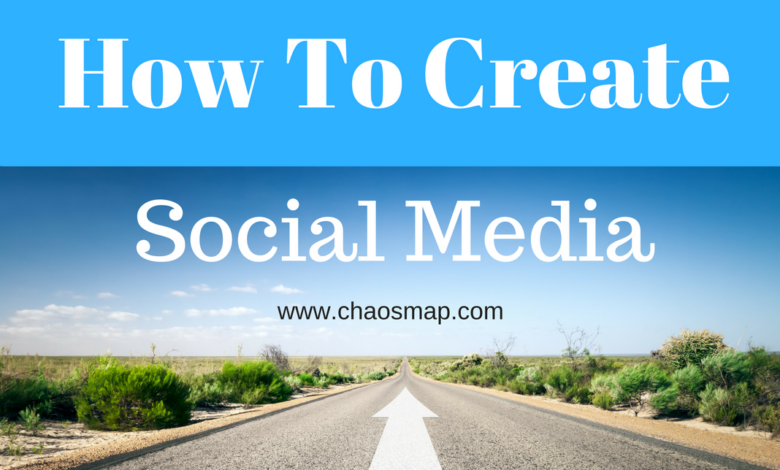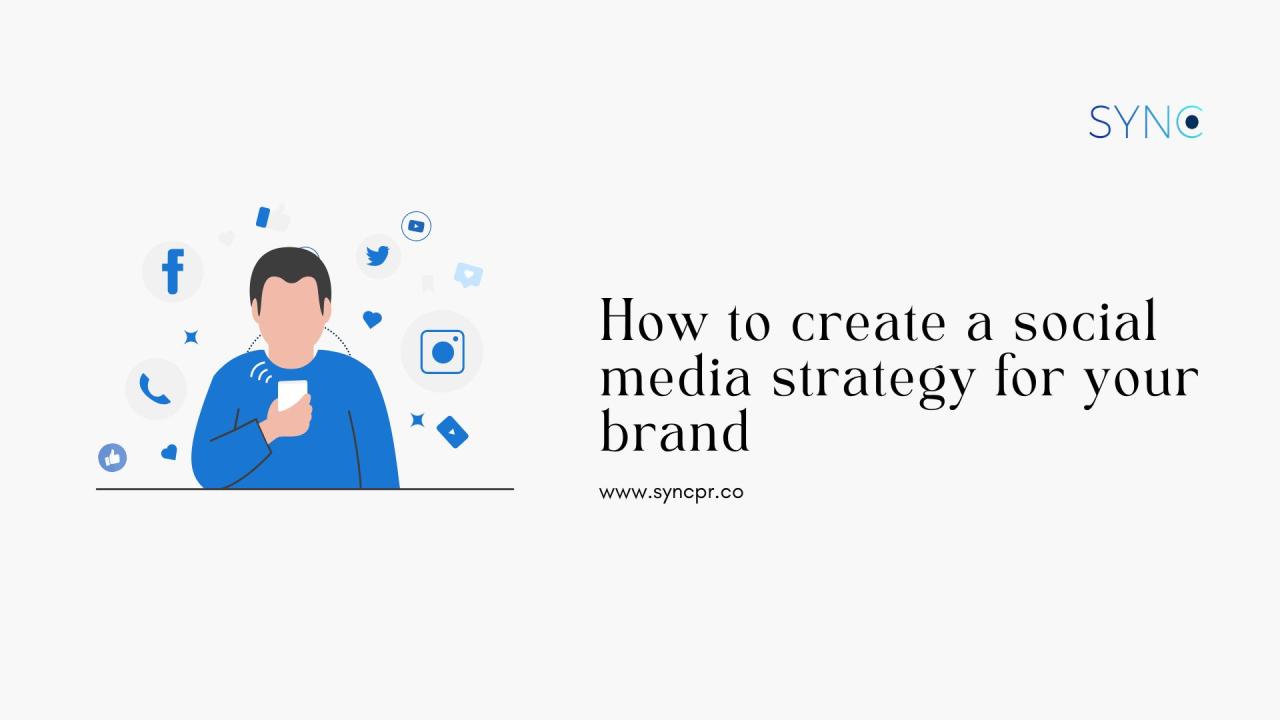
Social Media Plan Development A Guide
Social media plan development isn’t just about posting pretty pictures; it’s about crafting a strategic roadmap to connect with your audience, build your brand, and achieve your business goals. This journey takes us through defining clear objectives, identifying your ideal customer, creating compelling content, selecting the right platforms, and finally, measuring your success. Think of it as building a house – you wouldn’t start laying bricks without a blueprint, right?
This guide will be your blueprint for social media success.
We’ll dive deep into creating SMART goals, designing buyer personas, developing content calendars, and optimizing your chosen platforms. We’ll also cover the crucial aspects of community engagement, analyzing your results, and managing your budget effectively. Get ready to transform your social media presence from a chaotic mess into a well-oiled, goal-crushing machine!
Defining Goals and Objectives for a Social Media Plan
A successful social media strategy isn’t built on guesswork; it’s grounded in clearly defined goals and objectives. Without a roadmap outlining what you hope to achieve, your efforts will be scattered and your results difficult to measure. This section explores how to establish SMART goals and relevant KPIs for various social media campaigns.
Crafting effective social media goals requires a strategic approach. It’s about understanding your target audience, your brand’s strengths, and the overall business objectives. By setting clear goals, you can allocate resources effectively, track progress accurately, and ultimately achieve a greater return on your investment.
SMART Goals for a Hypothetical Bakery’s Social Media Presence, Social media plan development
Setting SMART (Specific, Measurable, Achievable, Relevant, Time-bound) goals is crucial for any social media plan. For a hypothetical bakery, three SMART goals could be:
These goals are specific, measurable, achievable within a reasonable timeframe, relevant to the bakery’s business, and time-bound, allowing for progress tracking and adjustments.
- Increase Instagram followers by 20% in three months through engaging content, including high-quality images of baked goods and behind-the-scenes glimpses of the bakery’s operations, and by running targeted ads to reach potential customers within a 5-mile radius.
- Generate 100 online orders through social media promotions (e.g., discounts, contests) within two months by utilizing targeted advertising campaigns on Facebook and Instagram, and by partnering with local food bloggers or influencers for product reviews and giveaways.
- Improve customer engagement (likes, comments, shares) on Facebook posts by 15% within one month by implementing a consistent posting schedule, responding promptly to comments and messages, and running interactive polls and Q&A sessions.
Social Media Strategy for Increasing Brand Awareness of a New Clothing Line
A social media strategy for a new clothing line should focus on building brand awareness and creating a strong online presence. This involves a multi-platform approach, leveraging visually appealing content and engaging with the target audience.
To achieve this, a combination of strategies is necessary. High-quality visuals are paramount, showcasing the clothing line’s style and aesthetic. Influencer marketing can significantly boost reach and credibility. Targeted advertising on platforms like Instagram and TikTok can further expand brand visibility.
A potential strategy could involve collaborating with fashion bloggers and influencers to showcase the clothing line. Running contests and giveaways on Instagram could drive engagement and increase follower count. Utilizing visually stunning images and videos on platforms like Pinterest and Instagram can attract a wider audience. Creating engaging stories on Instagram and TikTok can further enhance brand visibility and increase interaction with potential customers.
Key Performance Indicators (KPIs) for a Social Media Campaign Aimed at Boosting Online Sales
Tracking the right KPIs is essential to assess the success of a social media campaign focused on driving online sales. These metrics provide insights into campaign effectiveness and inform future strategies.
Several key metrics are critical for evaluating the performance of a sales-driven social media campaign. These metrics provide a comprehensive understanding of the campaign’s impact and allow for data-driven optimization. By tracking these KPIs, businesses can make informed decisions about resource allocation and campaign adjustments.
| KPI | Description | Example |
|---|---|---|
| Website Click-Through Rate (CTR) | Percentage of users who click on a link from a social media post to the website. | A CTR of 5% indicates that 5 out of every 100 users who saw the post clicked on the link. |
| Conversion Rate | Percentage of website visitors who complete a desired action (e.g., purchase). | A conversion rate of 2% suggests that 2 out of every 100 website visitors made a purchase. |
| Return on Ad Spend (ROAS) | Measure of the profitability of advertising campaigns. | A ROAS of 3:1 means that for every dollar spent on advertising, three dollars were generated in revenue. |
| Social Media Sales | Direct sales attributed to social media marketing efforts. | Tracking sales originating from unique social media links or promotional codes. |
Identifying the Target Audience

Source: syncpr.co
Understanding your target audience is crucial for a successful social media strategy. Without a clear picture of who you’re trying to reach, your messaging will fall flat, and your marketing efforts will be less effective. This section delves into defining target audiences, specifically for a fitness app and a B2B software company, highlighting the nuances of different demographics and optimal social media platforms.
Buyer Personas for a Fitness App
Creating detailed buyer personas helps to visualize and understand your ideal customer. This allows for more targeted and effective marketing campaigns. Below are two examples of buyer personas for a hypothetical fitness app:
Persona 1: The Busy Professional (Sarah)
Demographics: 30-45 years old, female, high income, lives in a city, holds a managerial position.
Interests: Career advancement, health and wellness (specifically stress reduction and maintaining energy levels), healthy eating, networking events, efficient time management.
Online Behavior: Active on LinkedIn and Instagram, uses fitness-related hashtags, engages with articles and posts about time management and productivity, follows health and wellness influencers.
Persona 2: The Fitness Enthusiast (Mark)
Demographics: 22-30 years old, male, student or entry-level professional, moderate income, lives in a suburban area.
Interests: Weightlifting, running, CrossFit, competitive sports, healthy recipes, fitness challenges, workout gear.
Online Behavior: Highly active on Instagram and TikTok, follows fitness influencers and athletes, participates in online fitness communities, uses fitness-related apps and trackers, shares workout progress and achievements.
Crafting a killer social media plan requires a multifaceted approach, considering all your platforms. A key element often overlooked is video marketing, and that’s where understanding YouTube comes in. Check out this awesome guide on getting it on with YouTube to boost your strategy. Once you’ve mastered YouTube, integrating that success into your overall social media plan will yield amazing results.
Social Media Platforms for Different Demographics
The optimal social media platform varies significantly depending on the target demographic. Younger demographics (18-35) are more likely to be highly engaged on platforms like TikTok, Instagram, and Snapchat, prioritizing visual content and short-form videos. These platforms emphasize trends, immediate gratification, and interactive features. Older demographics (35+) often favor platforms like Facebook, LinkedIn, and even YouTube, preferring longer-form content, in-depth articles, and community engagement focused on shared interests and professional networking.
While overlap exists, understanding these platform preferences is key to effective targeting.
Top Social Media Platforms for B2B Software Solutions
For B2B companies, the goal is to reach decision-makers and influencers within other businesses. The following table Artikels three top platforms and their suitability for this purpose:
| Platform | Strengths | Weaknesses | Target Audience |
|---|---|---|---|
| Professional networking, targeted advertising, industry insights, lead generation | Can be less visually engaging than other platforms, requires a professional approach | Business professionals, decision-makers, industry influencers | |
| Real-time updates, industry news, quick communication, thought leadership | Character limits can restrict messaging, high volume of content can lead to information overload | Industry experts, potential clients, early adopters | |
| YouTube | Demonstrations, tutorials, thought leadership, building trust and credibility | Requires high-quality video production, takes time to build an audience | Tech-savvy professionals, potential clients seeking detailed information |
Content Strategy and Planning
Crafting a successful social media strategy requires a well-defined content plan. This plan acts as a roadmap, guiding your posts and ensuring consistent engagement with your target audience. A strong content strategy considers the platform, the audience, and the overall marketing goals. It’s not just about posting; it’s about creating a narrative that resonates and drives results.
Developing a Content Calendar for a Travel Agency
A monthly content calendar provides structure and consistency for a travel agency’s social media presence. It allows for strategic planning, ensuring a mix of promotional and engaging content. The calendar should consider seasonal trends, upcoming holidays, and any special promotions the agency is running.
| Date | Platform | Content Type | Topic | Goal |
|---|---|---|---|---|
| October 1st | Image Post | Stunning autumn foliage in Vermont | Drive engagement, showcase destination | |
| October 5th | Video | Client testimonial about recent trip to Iceland | Build trust, showcase positive experiences | |
| October 10th | Reels | Quick tips for packing light for a weekend getaway | Provide value, increase engagement | |
| October 15th | Blog Post Link | Guide to the best hiking trails in the Rockies | Drive traffic to website, establish expertise | |
| October 20th | Story | Behind-the-scenes look at office life | Humanize brand, increase familiarity | |
| October 25th | Image Post | Special offer: 20% off flights to Europe | Drive bookings, increase sales | |
| October 30th | Reels | Timelapse of a beautiful sunset in Santorini | Visually appealing content, promote destination |
Diverse Content Ideas for Instagram Reels Promoting a New Restaurant
Instagram Reels offer a dynamic way to showcase a new restaurant’s offerings and ambiance. Variety is key to keeping the audience engaged. The following ideas leverage different aspects of the restaurant experience.
- A quick tour of the restaurant, highlighting the decor and atmosphere.
- A behind-the-scenes look at the kitchen, showcasing the chefs preparing dishes.
- A compilation of customer testimonials, showing satisfied diners enjoying their meals.
- A cooking demonstration of a signature dish, showing the process and ingredients.
- A fun and engaging challenge related to the restaurant’s food or theme (e.g., a taste test or a recipe recreation).
Engaging Captions for Facebook Posts Promoting a Charity Event
Captions for Facebook posts promoting a charity event should be compelling and emotionally resonant. They need to clearly communicate the event’s purpose, benefits, and call to action.
- “Join us in making a difference! Our annual charity gala supports [Charity Name] and their vital work in [Area of Focus]. Learn more and get your tickets here: [Link]”
- “Every dollar counts! Support [Charity Name] at our upcoming fundraising event. Your generosity will help [Specific Impact of Donation]. Donate today: [Link]”
- “Get ready for a night of fun, food, and fundraising! Join us for [Event Name] to support [Charity Name] and celebrate their incredible achievements. RSVP by [Date]: [Link]”
- “Meet the incredible people behind [Charity Name]! Learn about their inspiring work and how you can get involved at our upcoming event. Learn more: [Link]”
- “Let’s make a difference together! Your participation in [Event Name] will directly impact the lives of [Target Beneficiaries]. Register now: [Link]”
Platform Selection and Optimization
Choosing the right social media platform is crucial for a successful product launch or business growth. Each platform has its own strengths and weaknesses, and understanding these nuances is key to maximizing your reach and impact. This section will explore the considerations involved in selecting and optimizing platforms for different business goals.
TikTok versus Instagram for Beauty Product Launch
TikTok and Instagram are both popular platforms for beauty product launches, but they cater to different audiences and offer distinct advantages. TikTok, with its short-form video format, excels at viral marketing and reaching a younger demographic. Its algorithm prioritizes engaging content, making it ideal for showcasing product demonstrations, user-generated content, and behind-the-scenes glimpses. However, its highly saturated environment necessitates a creative and consistent approach to stand out.
Instagram, on the other hand, offers a more polished and curated aesthetic, better suited for building brand identity and engaging with a more established audience. Its robust features, including shopping capabilities and detailed analytics, allow for targeted advertising and precise performance tracking. A successful beauty product launch might leverage both platforms, using TikTok for rapid reach and virality, and Instagram for long-term brand building and sales.
For example, a brand could launch a TikTok challenge to promote a new lipstick, then use Instagram to showcase high-quality images and detailed product information.
Instagram Profile Design for Handcrafted Jewelry Business
A visually appealing Instagram profile is essential for a handcrafted jewelry business. The profile picture should be a high-resolution logo or a compelling image representing the brand’s aesthetic. Imagine a close-up shot of a beautifully crafted necklace, highlighting the intricate details and craftsmanship. The bio should be concise and impactful, clearly stating the business’s name, what it offers (e.g., “Handcrafted gemstone jewelry”), and a compelling call to action (e.g., “Shop now via link in bio”).
It could also include relevant s like “handmade,” “jewelry designer,” or specific materials used. Highlight covers should be visually consistent with the overall brand aesthetic, using high-quality images or graphics. For instance, one highlight could be titled “New Arrivals” with a picture of a stunning new piece; another could be “Customer Reviews” with an image featuring positive testimonials.
Each highlight should be carefully curated to showcase the brand’s best work and customer experiences.
LinkedIn Company Page Optimization for Attracting Business Partners
Optimizing a LinkedIn company page to attract potential business partners involves several key strategies. First, the company’s profile picture and cover image should be professional and high-quality, reflecting the brand’s identity and values. The “About Us” section should clearly articulate the company’s mission, vision, and value proposition, highlighting its unique strengths and expertise. It’s crucial to include s that potential business partners might search for, such as the company’s industry, services offered, and target market.
Regularly posting engaging content, such as industry news, company updates, and thought leadership articles, can significantly enhance visibility and attract potential partners. Actively engaging with other users’ posts and participating in relevant industry groups demonstrates active participation and fosters networking opportunities. Finally, leveraging LinkedIn’s advertising features can target specific demographics and industries to reach potential business partners directly.
For example, a company could target individuals with specific job titles or experience within their industry, showcasing their services and fostering connections.
Community Engagement and Management
Building a thriving online community is crucial for any social media strategy. It’s not just about broadcasting your message; it’s about fostering genuine connections with your audience, turning followers into advocates. This involves actively listening, responding thoughtfully, and creating opportunities for two-way communication. Effective community management directly impacts brand loyalty, increases visibility, and ultimately drives sales.Responding to comments, both positive and negative, is a fundamental aspect of community engagement.
A well-defined plan ensures consistency and professionalism, protecting your brand’s reputation.
Responding to Positive and Negative Comments
A prompt and positive response to positive comments strengthens the bond with your audience. Thank users for their support, share their feedback with your team, and consider featuring positive comments on your feed to showcase appreciation. For negative comments, acknowledge the user’s concern, empathize with their experience, and offer a solution or explanation. Avoid getting defensive; instead, focus on understanding their perspective and finding a resolution.
Publicly addressing negative comments demonstrates transparency and shows that you value customer feedback. For complex issues, offer to take the conversation offline via direct message to maintain privacy and professionalism. A well-managed response to negative feedback can even turn a negative experience into a positive one, showcasing your commitment to customer satisfaction. This demonstrates your brand’s commitment to customer service and fosters trust.
Running a Successful Q&A Session on Instagram Live
Instagram Live provides an excellent platform for real-time interaction with your audience. For a skincare brand, a Q&A session can be incredibly effective. Pre-planning is key. Create a list of frequently asked questions (FAQs) to anticipate common queries. Promote the session well in advance, using engaging visuals and highlighting the specific topics to be covered.
During the live session, engage actively with comments, responding promptly and thoughtfully. Use visuals like product demos or close-ups to enhance the experience. Consider having a second person manage the comments and questions, allowing you to focus on presenting information clearly and engagingly. After the session, post a summary of key takeaways and unanswered questions on your feed, showing that you value audience participation and addressing all concerns.
This allows for continued engagement after the live stream concludes. Example: A skincare brand could showcase different products and answer questions about ingredients, application, and results.
Increasing Follower Interaction and Engagement on Twitter
Twitter’s fast-paced nature requires a dynamic approach to engagement. Here are three methods to increase interaction:
- Run Polls and Quizzes: Interactive polls and quizzes encourage participation and gather valuable data about your audience’s preferences and interests. For example, a skincare brand could poll its followers on their preferred skincare routine steps or favorite product types.
- Host Twitter Chats: Schedule regular Twitter chats using a relevant hashtag. This creates a dedicated space for discussion and fosters a sense of community. Example: A skincare brand could host a weekly chat about skincare concerns, offering expert advice and interacting with participants in real-time.
- Engage with Relevant Hashtags and Trends: Actively participate in conversations around relevant hashtags and trending topics. This increases your brand’s visibility and allows you to connect with a wider audience. For example, a skincare brand could participate in discussions about beauty trends, skin health, or self-care.
Measuring and Analyzing Results

Source: hislide.io
Understanding how your social media efforts are performing is crucial for any online business. Without proper measurement and analysis, you’re essentially throwing darts in the dark, hoping some land on the target. For an online bookstore, this means tracking key metrics to understand what’s working, what’s not, and how to adjust your strategy for better results. This involves going beyond simply looking at follower counts and diving into the data that truly reveals your audience engagement and campaign effectiveness.
Social Media Metrics for an Online Bookstore
Analyzing social media performance requires a focused approach. It’s not enough to simply track vanity metrics like follower count. Instead, we need to focus on metrics that directly relate to business goals, such as website traffic and sales. The following table Artikels some key metrics, their meaning, and strategies for improvement within the context of an online bookstore.
| Metric | Meaning | Improvement Strategies | Example Data (Hypothetical) |
|---|---|---|---|
| Website Click-Through Rate (CTR) | Percentage of users who click on links from your social media posts to your website. | Use compelling visuals, strong calls to action (CTAs), and trackable short links. A/B test different CTAs and post formats. | Current: 2%, Target: 5% |
| Engagement Rate | Measure of how much users interact with your posts (likes, comments, shares). | Post engaging content relevant to your target audience. Run contests and giveaways. Respond promptly to comments and messages. | Current: 3%, Target: 5% |
| Conversion Rate | Percentage of website visitors who complete a desired action (e.g., purchase a book). | Optimize your website for conversions. Use targeted advertising. Offer discounts and promotions. | Current: 1%, Target: 2% |
| Reach | Number of unique users who saw your posts. | Use paid social media advertising to expand reach. Collaborate with influencers. Optimize your posting schedule. | Current: 5000, Target: 10000 |
Visual Representations of Social Media Performance
Visualizations make complex data easy to understand and act upon. For an online bookstore, three effective visual representations of social media performance data would be:
1. Line Graph Showing Engagement Rate Over Time: This graph would display the engagement rate (percentage of interactions per post) over a specific period, perhaps a month or a quarter. The x-axis would represent time, and the y-axis would represent the engagement rate. A clear upward trend would indicate a successful strategy, while a downward trend would highlight areas needing improvement.
For example, a dip in engagement might coincide with a change in content strategy, indicating a need for adjustment.
2. Bar Chart Comparing Website Traffic from Different Social Media Platforms: This chart would compare the amount of website traffic driven by each social media platform (e.g., Facebook, Instagram, Twitter). The x-axis would represent the platforms, and the y-axis would represent the number of website visits. This allows for a quick comparison of which platforms are most effective at driving traffic to the bookstore’s website, enabling the allocation of resources to the most successful channels.
3. Pie Chart Showing the Distribution of Website Conversions Across Different Social Media Campaigns: This chart would show the proportion of website conversions (e.g., book purchases) attributed to different social media campaigns. Each slice of the pie would represent a campaign, and the size of the slice would correspond to the number of conversions. This helps identify which campaigns are most effective in driving sales, informing future campaign planning and budget allocation.
For example, a campaign focused on a specific genre might show significantly higher conversion rates than a more general campaign.
Interpreting Social Media Analytics to Inform Future Strategies
Social media analytics are not just about tracking numbers; they’re about understanding thewhy* behind those numbers. For instance, a low engagement rate might indicate that the content isn’t resonating with the target audience, or that the posting schedule is ineffective. A high click-through rate but a low conversion rate suggests a problem with the website’s user experience or call to action.
By analyzing the data, you can identify areas for improvement, such as refining content strategy, optimizing website design, adjusting ad targeting, or experimenting with different posting times. This iterative process of analyzing, adapting, and testing is crucial for achieving long-term success on social media. For example, if a particular author’s book consistently generates high engagement and conversions, the bookstore can focus on promoting more books by that author or books within that genre.
Budget Allocation and Resource Management: Social Media Plan Development
Successfully navigating the world of social media marketing requires a well-defined budget and efficient resource management. Ignoring these crucial aspects can lead to wasted resources and ultimately, a less effective campaign. This section Artikels how to create a realistic budget, manage resources effectively, and justify social media marketing spend to stakeholders.Creating a comprehensive budget ensures you allocate funds strategically across various campaign elements.
Without a budget, you risk overspending in certain areas and neglecting others that could contribute significantly to your success. Efficient resource management is equally vital for maximizing the impact of your budget and achieving your campaign goals.
Six-Month Social Media Marketing Campaign Budget
This example budget Artikels costs for a six-month campaign targeting a small business. Adjust figures based on your specific needs and resources. Remember that this is a
sample* and actual costs will vary depending on factors such as the complexity of content, the chosen platforms, and the geographic reach of the campaign.
| Expense Category | Monthly Cost | Total (6 Months) |
|---|---|---|
| Content Creation (graphics, videos, copywriting) | $500 | $3000 |
| Social Media Advertising (Facebook, Instagram, etc.) | $750 | $4500 |
| Social Media Management Tools (scheduling, analytics) | $50 | $300 |
| Community Management (engagement, responding to comments) | $200 | $1200 |
| Contingency Fund (unforeseen expenses) | $100 | $600 |
| Total | $1600 | $9600 |
Methods for Efficient Time and Resource Management
Effective time management is paramount when managing multiple social media accounts. Prioritization and scheduling are key. Utilizing social media management tools can significantly streamline workflows, enabling you to schedule posts in advance, analyze performance data, and manage interactions across platforms from a central dashboard.
Consider these strategies:
- Batch Content Creation: Dedicate specific blocks of time to create content for all platforms simultaneously, maximizing efficiency.
- Utilize Scheduling Tools: Tools like Hootsuite or Buffer allow you to schedule posts across various platforms, saving significant time.
- Prioritize Tasks: Focus on activities that deliver the highest return on investment (ROI), such as engaging with your audience and analyzing campaign performance.
- Delegate Tasks: If budget allows, consider outsourcing certain tasks, such as graphic design or video editing.
Justifying the Cost of Social Media Marketing
Demonstrating the ROI of social media marketing is crucial for securing budget approval from stakeholders. This requires tracking key metrics and presenting data that clearly shows the value of your efforts.
Here are some ways to justify social media marketing costs:
- Track Key Metrics: Monitor metrics like website traffic, lead generation, brand mentions, and customer engagement to demonstrate the impact of your campaigns.
- Calculate ROI: Compare the cost of your social media marketing efforts with the revenue generated or cost savings achieved as a result.
- Showcase Success Stories: Highlight specific examples of how social media marketing has driven positive results for your business, such as increased sales or improved brand awareness.
- Present a Comprehensive Report: Create regular reports that summarize your social media performance and demonstrate the return on investment.
Closure

Source: chaosmap.com
Developing a successful social media plan is an ongoing process, not a one-time event. It requires consistent effort, adaptation, and a willingness to learn and evolve. By following the steps Artikeld in this guide, you’ll have a solid foundation for building a thriving online community, increasing brand awareness, and ultimately achieving your business objectives. Remember to track your progress, analyze your results, and adjust your strategy as needed.
The world of social media is constantly changing, so stay flexible and keep innovating! Now go forth and conquer the social media landscape!
FAQ Explained
What’s the difference between organic and paid social media marketing?
Organic social media marketing relies on creating and sharing content without paying for promotion. Paid social media marketing involves using paid advertising to reach a wider audience.
How often should I post on social media?
The optimal posting frequency varies depending on your platform, audience, and industry. Experiment to find what works best for you, but consistency is key.
How do I measure the ROI of my social media efforts?
Track key metrics like website traffic, lead generation, and sales conversions attributed to your social media activities. Compare these results to your marketing spend to calculate ROI.
What are some common social media mistakes to avoid?
Common mistakes include inconsistent posting, ignoring comments and engagement, focusing solely on self-promotion, and not tracking your results.





